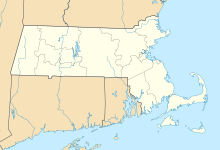East Chop Light
 |
|
| Location | Lighthouse Road, Oak Bluffs, Massachusetts |
|---|---|
| Coordinates | 41°28′12.95″N 70°34′2.825″W / 41.4702639°N 70.56745139°WCoordinates: 41°28′12.95″N 70°34′2.825″W / 41.4702639°N 70.56745139°W |
| Year first constructed | 1869 |
| Year first lit | 1878 (current structure) |
| Foundation | Concrete |
| Construction | Cast Iron |
| Tower shape | Conical |
| Markings / pattern | White with black lantern |
| Height | 40 feet (12 m) |
| Focal height | 79 feet (24 m) |
| Original lens | 12 inches (300 mm) |
| Range | 9 nautical miles (17 km; 10 mi) |
| Characteristic | Isophase Green 6s |
| Fog signal | none |
| Admiralty number | J0446 |
| ARLHS number | USA-259 |
| USCG number |
1-13745 |
|
East Chop Light
|
|
| Area | 0.1 acres (0.040 ha) |
| Built | 1876 |
| Architectural style | Italianate |
| MPS | Lighthouses of Massachusetts TR |
| NRHP Reference # | 87001480 |
| Added to NRHP | June 15, 1987 |
| Heritage | place listed on the National Register of Historic Places |
|
[]
|
|
1-13745
East Chop Light is a historic lighthouse standing on a bluff overlooking Vineyard Haven Harbor and Vineyard Sound, located along East Chop Drive in the town of Oak Bluffs, Massachusetts. It is one of five lighthouses located on the island of Martha's Vineyard.
The East Chop Light was built in 1878 and added to the National Register of Historic Places in 1987. In the early 1800s the location was occupied by a semaphore station - thus the origin of the name "Telegraph Hill." Circa 1869 a marine merchant named Captain Silas Daggett constructed a privately owned lighthouse on the property. To pay for construction and maintenance, Daggett collected fees from local merchants, maritime insurance agencies, and ship owners who benefited from the light as an aid-to-navigation. Daggett's 1869 lighthouse was the last of the six lighthouses to be constructed on Martha's Vineyard. The oil-fired East Chop Light burned down in 1871. The light was rebuilt by Daggett in 1872 as a house with a protruding lantern room - similar in concept to the first Edgartown Harbor Light. Daggett's new East Chop Light produced a red signal and had three 21-inch reflectors fueled by kerosene lamps. In 1875, the United States Congress purchased the property for $6,000 and removed the lighthouse and other buildings constructed by Daggett. In 1878 the present day cast-iron conical tower with a fourth-order Fresnel lens was constructed along with an adjacent two-story gabled roof keeper's house. The lighthouse was originally painted white, but was repainted as a brown-red color in the 1880s. The brown-red color was maintained until 1988, when the light was painted white by Vineyard Environmental Research, Institute (VERI). Many people in the East Chop community and elsewhere still harbor fond memories of their "Chocolate Lighthouse." In 1933 the East Chop Light was automated. At the time, the United States Coast Guard (USCG) offered to rent the Keeper's dwelling to longtime keeper, George Walter Purdy. Purdy, who had one arm, served as the East Chop Light's principal keeper for thirty-two years. Purdy refused the offer, and shortly afterwards, the keeper's dwelling, fuel oil shed, and other outbuildings were torn down. Without a keeper on the lighthouse grounds, the USCG closed the East Chop Light to public access.
From 1878 through the early 1980s, the East Chop Light was maintained by the United States Coast Guard. Due to U. S. Coast Guard Congressional funding shortages through the 1970s and early 1980s, various lighthouses around the United States were destroyed or designated for destruction. Such designation was due to the high cost of maintaining the structures, and because the lights no longer served as vital aids to navigation. This obsolete status of the lighthouses was facilitated by enhanced satellite GPS and other electrical maritime navigation aids. In fact, according to the 2012 "Doomsday List" published by Lighthouse Digest, there are currently 43 lighthouses in the U.S. listed for destruction in the near future. Due to such funding shortages, the East Chop Light and two other Martha's Vineyard lighthouses (Gay Head Light and Edgartown Harbor Light) were designated for destruction in the early 1980s. These three island lights were saved through federal petition and Congressional testimony of Vineyard Environmental Research, Inst, Founder/President, William Waterway Marks, and, Chair, John F. Bitzer, Jr. During and after the Congressional hearings, this effort received support from Congressman Gerry Studds, and Senator Ted Kennedy. Shortly after the Congressional hearings, the United States Coast Guard issued a 35-year license for the three lights to VERI in 1985.
...
Wikipedia

